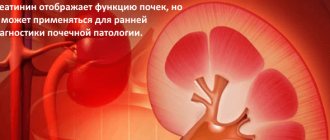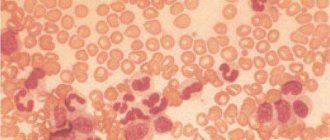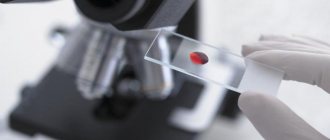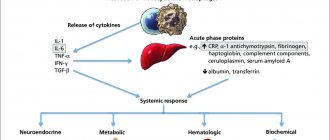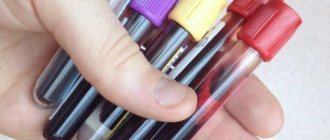What is hemoglobin and what is its role in the body
A high-molecular organic substance saturated with iron is hemoglobin, which, in fact, is a protein of animals with a circulatory system. In the human body, this iron-containing substance is found in the cytoplasm of red blood cells (erythrocytes), its synthesis occurs in the bone marrow. Hemoglobin gives red blood cells their red color. The role of cells containing an iron atom is to saturate tissues and organs with oxygen and remove metabolic products (carbon dioxide) from them.
In addition to transporting oxygen, participating in the respiration process, the high-molecular substance performs a buffer function, which is to maintain the constancy of the acid-base balance of the circulatory system. The hemoglobin buffer system is one of the most powerful in the body, occupying almost a quarter of the entire buffer capacity (the totality of all living plasma and blood cells).
In terms of its structure, hemoglobin belongs to the class of chromoproteins (complex proteins consisting of a simple protein and a non-protein component). Outside of erythrocytes, this complex protein is a highly toxic substance and its entry into the blood plasma leads to tissue hypoxia. A deficiency or excess of this element in the blood is a pathology and requires appropriate treatment. Blood tests should be performed periodically to monitor iron protein levels.
Hemoglobin and its functional purpose
Hemoglobin is an important component of the red blood cell, the configuration of which is a protein of complex microstructure. The main components of blood pigment are the elements of protein and iron. Iron-containing protein, due to its complex structural system, performs an important function, namely transporting oxygen throughout the body, delivering it to every cell of the organ, ensuring their normal functionality. In parallel with the supply of oxygen, erythrocyte elements buffer toxic carbon dioxide and negative components of metabolism.
You can find out about the quantitative values of pigment in the blood by submitting the liquid for a general analysis in any medical laboratory. Changes in values downward or upward mainly indicate the presence of obvious or hidden problems with the patient’s health. The hemoglobin level is a kind of litmus test of people's health; its significant deviations from the standard should be the reason for additional research in order to identify the cause of such an incident and timely begin to eliminate it.
Let us further consider what pigment indicator is considered standard for different age categories, as well as its maximum fluctuations within normal limits, which depend on a person’s gender, area of activity and hormonal background.
Hemoglobin norm
Accurate information about the amount of protein of the chromprotein group in the blood can only be obtained by passing the necessary tests. When deciphering diagnostic results, it should be borne in mind that the level of iron-containing substances may change throughout life. The indicators are influenced by factors such as age, quality of nutrition, bad habits, and physical activity. Hemoglobin in a newborn’s blood test is very high and is given a special term – fetal. By the first year of a child's life, fetal protein is completely destroyed and replaced by adults.
Hemoglobin levels in men are higher than in women, which is explained by the stimulating effect of the male hormone testosterone on the process of blood formation. The established normal values are as follows:
| Lower limit g/l | Upper limit g/l | |
| Men | 120 | 180 |
| Women | 120 | 150 |
| Pregnant women | 110 | 155 |
| Children 1-3 days of life | 145 | 225 |
| Children 3-6 months | 95 | 135 |
| Children from 1 year to 18 years | Gradual increase to levels similar to those of adults | |
Types of free hemoglobin
The bulk of free hemoglobin is concentrated in the human liver, the rest is in the plasma. There are two types of this protein:
- Fetal. It is diagnosed only in the blood of newborn babies. By 10–12 months, its structure changes to normal, the concentration decreases from 80% to 1%.
- Glycated. The protein is formed when it binds to glucose molecules. Based on its amount in the analysis, doctors can accurately identify diabetes mellitus at an early stage.
The level of hemoglobin is affected not only by the patient’s age: during the day it changes by 5–6%, reacts to lack of sleep, fatty or sweet foods, and the person’s stressful state. But the indicator is not used in the comprehensive diagnosis of chronic diseases.
Important! The level of free hemoglobin shows how harmoniously and correctly the patient’s organs and systems work. It helps to identify hidden inflammation and disorders of intravascular hemolysis, heart valve pathologies, and atherosclerosis.
Degrees of anemia
A decrease in the concentration of iron-containing protein in the blood is called anemia or anemia. This condition is characterized by a decrease in the number of red blood cells and manifests itself in specific symptoms. Anemia is not considered as an independent disease - it is one of the signs of pathological processes occurring in the body. For use in clinical practice, anemia is classified into the following groups according to the severity of the decrease in hemoglobin levels:
| Lightweight | Average | Heavy | |
| Level (g/l) | Up to 90 | 70-90 | Less than 70 |
| Symptom severity | Weak | Moderate | Strong |
| Symptoms | General weakness, excessive sweating, permanent feeling of fatigue, emotional decline | Headaches, dizziness, increased dryness and flaking of the skin, cracks in the corners of the lips, drowsiness, constant fatigue, arrhythmia, heart pain, shortness of breath, indigestion | Loss of consciousness, alopecia, pallor of the skin, changes in the structure of the nails, destruction of tooth enamel, numbness of the limbs, impaired taste and olfactory sensations |
Patients suffering from anemia are often unaware of the presence of the disease and attribute increased fatigue to stress or lack of sleep. Seeking medical help occurs only in the third stage of the disease, when tangible heart problems appear. Downplaying the danger of anemia can lead to serious consequences, so a hemoglobin test is one of the most important laboratory tests.
Free hemoglobin standards for children
In the first months of life, the level of free hemoglobin in the baby’s blood exceeds 80% of the total. This is due to rapid metabolism, increased work of the kidneys and hematopoietic system, which ceases to depend on the maternal one. The following indicator is considered normal:
- first week up to 230 g/l;
- up to 6 months reduction to 140 g/l;
- per year after birth 145–160 g/l.
In addition to age standards, dietary habits and the introduction or absence of complementary foods should be taken into account. With anemia, children's growth and development slows down, they gain weight poorly, and the child becomes more irritable and whiny. During puberty, gender and hormonal characteristics begin to influence the level.
Methods for determining hemoglobin levels
A blood test for hemoglobin is one of the most widespread due to its importance for diagnostic practice. The determination of iron-containing protein occurs by analyzing its derivatives formed during oxidation reactions and the addition of other chemical elements. Saponin, Sali, chemical, spectrophotometric methods, although they have high accuracy, are not used for routine laboratory research due to the labor-intensive and expensive process.
The advent of modern diagnostic equipment has greatly simplified the analysis. The methods currently used are simple and quick to implement. The main ways to determine the content of an important element in the blood are:
- colorimetric (hemichrome, calibration, hemiglobincyanide) - consist of adding chemicals to the blood and determining the amount of the desired substance by the color intensity of the resulting composition; the advantage of this group of methods is accessibility, the disadvantage is the likelihood of error;
- gasometric - based on the oxidation of biological material with chemical elements in an alkaline environment and measuring the amount of carbon monoxide released, the method is highly accurate, but the complexity and duration of calculations;
- identification of the quantitative iron content in a protein molecule - the use of specific reagents (acids, amino acids) to impart a characteristic ultraviolet absorption spectrum and detect the iron content using a spectrophotometer, the method gives accurate results, but takes a lot of time.
Methods for measuring hemoglobin in blood
To measure the indicator in the blood, several colorimetric methods are used:
- Hemiglobincyanide.
- Hemichromic.
- Sali's method.
- Ammonia.
After any of the methods, a semi-automatic analyzer is used that measures the wavelength spectrum of the hemoglobin molecule.
Automatic methods will not be able to recognize blood composition disorders, but will eliminate errors in calculating parameters. The manual method uses reagents and biological fluid and can only determine the presence or absence of cells.
Hemiglobincyanide method
Hemoglobin comes in many forms, making it difficult to measure its wavelength. To make the procedure easier, this indicator is converted to methemoglobin. To ensure the accuracy of the result, special equipment is used: measuring tubes, photoelectric colorimeter, transforming solution. The normal wavelength is 540 nm, and the device operates in this range. Calculations are made according to the formula, and the final indicator is converted to grams per liter (g/l).
Interesting fact! This method is used to determine hemoglobin levels less and less, due to the danger for laboratory technicians, since the reagent can cause burns to the skin and mucous membranes.
Hemichrome method
Using safe special reagents, hemoglobin is converted to cyanhemoglobin. For this purpose, SDS, fatty acid salts, and quaternary ammonium are used. As a result, hemichrome is formed, which is also measured by colorimetry in a photometer at a wavelength of 540 nm. At the end, they also use the calculation formula and convert the units of measurement to g/l.
The advantage of this method is the speed of reaction and obtaining results in a matter of minutes. Laboratories often use this method using Olvex reagents. They are completely safe, durable and economical.
Sali's method
A more outdated method of analysis that is rarely used. The principle is to add hydrochloric acid to the biomaterial, which helps convert hemoglobin into hematin hydrochloride. Next, add distilled water until the color turns brown and compare the colors with the control tube. The mark on the tube indicates the amount of the substance in 100 g of blood. To obtain a result in a liter, the indicators are multiplied by ten and the indicator is calculated using proportions.
Ammonia method
This method is based on the previous ones, only 0.04% ammonia is used as a solution. The sample is infused to convert all forms of hemoglobin into one. Next, the result is calculated using a photometer at a wavelength of 543 nm. The hemichromic method is considered the most accurate. In this way, the risk of error can be eliminated, since all calculations are carried out based on the indicators of the device. In addition, this method is the safest and does not harm laboratory technicians.
Hemoglobin is an important indicator for the doctor and the patient. Using this analysis, one can judge the presence of disease, bleeding and the state of the cardiovascular system. It is important to carry out analysis for the purpose of prevention in order to prevent anemia or pathological excess of the indicator. Laboratory data obtained must be interpreted by a physician. This is the only way to avoid complications of diseases and receive the correct treatment.
Rules for taking the analysis
Due to the fact that blood testing for hemoglobin, as an independent test, is rarely prescribed (more often when taking general tests), preliminary preparation is required. The patient is recommended to follow a number of rules so that the test results are not distorted by an atypical reaction of the body (for example, to food irritants, medications, physical activity). The basic training requirements are as follows:
- the day before the test, refrain from intense sports;
- exclude sweet and spicy foods from the diet;
- refrain from taking medications for 3-4 days before the test;
- blood is donated in the morning on an empty stomach (you can drink clean water on the day of donation);
- Do not smoke an hour before the test.
If other indicators are not important and only the determination of the protein content is significant, no preliminary preparation is required, since the amount of protein will not change in a short period of time, even under the influence of external and internal factors. The procedure involves pricking a finger and collecting a small amount of blood, after which the material is sent to a laboratory for testing. The results will be ready in 1-2 days.
In some cases, determining the amount of iron-containing protein has no diagnostic value and it is necessary to determine its qualitative composition. An important test for suspected diabetes is to determine the level of glycosylated (glycated) hemoglobin, i.e. part of the protein associated with glucose. This indicator is measured as a percentage and shows the average amount of glucose in the body over 100-120 days. Donating blood for this type of hemoglobin occurs by collecting material from a vein and does not require special preparation.
Free hemoglobin levels in adults
In people over 18 years of age, the indicator does not depend on age and remains relatively stable in the absence of health problems. But with any diets or violations of the daily routine, it should not exceed 2–4% of total hemoglobin. If the protein penetrates the plasma, the number of red blood cells in a person decreases, and fewer blood cells participate in the process of oxygen metabolism.
The main difficulty in diagnosing the level of free hemoglobin is that its determination requires a special comprehensive analysis. Bing and spectrophotometry methods involve the isolation of proteins from plasma, the study of serum albumin and cholesterol. Comparison of such indicators over time is used in cases of suspected stroke or myocardial infarction.
Normal values for women
For a woman of middle age and build, 120–150 g/l is considered normal. During monthly menstruation it drops to 110 g/l, but quickly returns to normal and does not require taking special medications or vitamins. Deviations occur in the following situations:
- smoking;
- hormonal imbalance due to pathologies of the reproductive system;
- menopause;
- strict diets;
- physical fatigue.
During pregnancy, the level of free hemoglobin drops: the woman’s body tries to “involve” all proteins in the transfer of oxygen. Doctors strictly monitor this indicator to prevent fetal hypoxia and pathologies of the development of the nervous system. But even exceeding the norm of 140 g/l carries the risk of thrombosis, varicose veins, and pulmonary embolism during delivery.
Causes of low hemoglobin
Low, relative to normal values, concentration of iron-containing protein is called oligochromemia (other terms - hemoglobinopenia, iron deficiency anemia). Hemoglobinopenia is often caused by diseases or pathological changes in the body. Along with diseases, iron deficiency anemia can be caused by an unbalanced diet or vegetarianism. The main causative factors for low hemoglobin levels are:
- acute blood loss;
- internal bleeding;
- the presence of neoplasms (tumors);
- autoimmune diseases;
- bone marrow lesions;
- prolonged damage to the body by infections or parasites (hepatitis, pneumonia, tuberculosis, helminthiasis, etc.);
- pathological changes in blood composition;
- disturbances in the production of hormones (thyroid or sex glands);
- the body's inability to absorb iron;
- lack of B vitamins (they are a catalyst for iron synthesis);
- taking certain medications;
- strict diet, prolonged fasting;
- frequent consumption of coffee (inhibition of iron absorption processes);
- alcohol abuse.
Consequences of low hemoglobin
Protein containing iron performs a number of important functions in the body, and a decrease in its normal value leads to disruption of the functioning of all systems, organs and tissues. If tests for hemoglobin show a low level, this indicates an oxygen deficiency, the consequences of which will become increasingly evident in the absence of measures taken. A decrease in iron content is especially dangerous for pregnant women and young children. A critically low level of this element can provoke premature birth and even cause fetal death.
The consequences of a decrease in the protein that transports oxygen are manifested in symptoms of hypoxia (oxygen starvation). At the first stage, changes occur in organs that are less important for life (skin, nails, hair), the body redistributes oxygen reserves and tries to save energy (loss of strength, fainting). If after these signs the protein level does not increase, the consequences may be as follows:
- menstrual irregularities (in women);
- sexual dysfunction (in men);
- arrest of mental and physical development (in children);
- decreased immunity;
- anorexia;
- spasms of the lower extremities;
- dysfunction of the lungs, heart, central nervous system;
- death.
How to increase
Tactical treatment for reduced protein levels depends on the degree of hemoglobin deficiency and consists of identifying and eliminating the causes of the decrease. If a deficiency of a substance occurs due to an unbalanced diet, its level can be increased through diet. But if deviations from the norm are caused by other factors, there is a need for specialized treatment using medications.
To optimize nutrition with a low level of iron-containing protein, you should know that iron (as a protein element) is divided into two types according to the rate of absorption by the body: heme (found in meat products) and non-heme (source of intake - plant foods). When eating meat, iron absorption is 20%, plant products – 6%. A diet to increase protein levels includes the following foods:
- liver (boiled);
- vegetables (beets, carrots);
- cheeses;
- yolk;
- meat (rabbit, turkey);
- beans, beans;
- hazelnuts;
- mushrooms;
- berries (raspberries, blueberries);
- fruits (peaches, apricots, apples).
If dietary adjustments are not possible for any reason or do not help increase protein levels, treatment with iron-containing drugs is prescribed. Pharmacological therapy should be carried out under the supervision of a physician to identify the patient’s body’s response to the medications taken. Treatment occurs by taking oral tablets or intravenous medications (via IVs or injections). The most popular and frequently prescribed drugs to increase hemoglobin are:
- Hemobin;
- Ferro foil;
- Maltofer;
- Irovit;
- Ferrum Lek;
- vitamin complexes (Fenuls, Nutrimax).
Norm for children
In children, Hb levels depend on age. In the first year of life, a physiological decrease in protein in the blood occurs, which is the norm for newborns.
To maintain normal Hb levels in a child’s blood, a pediatrician may prescribe a blood test 1-2 times a year. And children with a history of blood diseases should be tested more than 3 times a year.
The concentration of Hb in a child’s blood depends on his age:
| Child's age | Hb level, g/l |
| Newborn (1-2 days) | 140-220 |
| 3-6 months | 100-140 |
| 3-6 years | 140 |
| 6-12 years | 160 |
Attention! Lack of Hb in a child's body can lead to delayed mental and physical development. That is why it is very important to regularly monitor Hb levels in the first months of life.
Causes of elevated hemoglobin
If a hemoglobin test shows a high content of this element in the body, this does not mean that there is no cause for concern. Too high indicators also indicate deviations and may be signs of serious diseases. So, possible reasons for deviations from the norm in the level of protein containing iron are:
- violation of the relationship between blood inflow and outflow;
- changes in blood gas composition;
- congenital diseases of the cardiovascular system;
- pathological growth of connective tissue of the lungs;
- intestinal obstruction;
- dehydration;
- systemic oncological diseases;
- stressful conditions;
- long-term use of diuretics.
Other factors that increase iron protein levels include lifestyle conditions. The category of people for whom high hemoglobin levels are normal are residents of mountainous areas, athletes (cyclists, skiers, snowboarders), and smokers. Another reason for the increase in protein is a sharp increase in the number of red blood cells, which happens during a blood transfusion.
Consequences of increased performance
Hyperchromemia (increased levels of iron-containing protein) is not considered in clinical practice as an independent disease, but it can be pathological in nature and lead to the development of diseases such as:
- angina pectoris;
- acute myocardial ischemia;
- cerebrovascular accident;
- vascular atherosclerosis;
- increased blood viscosity;
- increased thrombus formation (as a result of blood thickening).
Hyperhemoglobinemia, which is not a physiological abnormality, but acts as a manifestation of a disease, manifests itself in the following symptoms:
- local hyperemia (redness of individual areas of the skin);
- frequent dizziness;
- drying of the mucous membranes, feeling of thirst;
- emotional imbalance, disruption of the body’s biological rhythms (insomnia at night, drowsiness during the day);
- pain in joints and muscles;
- weakness;
- problems with bowel movements (constipation).
How to downgrade
To bring the test values back to normal values, the cause of the increase in protein levels must be identified. After eliminating the causative factors, the amount of hemoglobin quickly normalizes. If it is not possible to identify or eliminate provoking factors, the basis of treatment is a diet that involves limiting or completely eliminating foods high in iron. The basic principles of nutrition to reduce iron protein levels are as follows:
| Products that need to be avoided or their consumption limited as much as possible | Recommended products for consumption |
| Red meat | White meat |
| Liver | Low-fat fish |
| By-products | Vegetables, fruits (green) |
| Buckwheat | Porridge (from cereals, except buckwheat) |
| Baking, confectionery | Dairy products |
| Fats (butter, margarine, lard) | Cheese |
| Canned food | Cottage cheese |
| Alcohol | |
| Red apples, pomegranates |
While applying therapeutic measures to reduce protein levels, you should stop taking vitamin complexes and dietary supplements. Also, in order to prevent thrombosis, it is not recommended to consume foods that increase cholesterol. There are no specific medications that lower hemoglobin levels, but if necessary, the doctor can prescribe prophylactic use of anticoagulants (blood thinners - Heparin, Antithrombin) and antiplatelet agents (Acetylsalicylic acid, Curantil).
HEMOGLOBINEMIA
HEMOGLOBINEMIA
(
haemoglobinaemia
; hemoglobin + Greek haima blood) - increased content of free hemoglobin in the blood plasma.
In healthy individuals, plasma contains only a small (1-4 mg%) amount of free hemoglobin. This is hemoglobin released from red blood cells that have completed their life cycle. In plasma, it binds mainly to haptoglobin (see), forming a haptoglobin-hemoglobin complex, which is then destroyed in the cells of the reticuloendothelial system - mainly in the liver, bone marrow, and spleen. This high-molecular complex is not excreted in urine. Other plasma proteins also bind both hemoglobin and its heme-containing metabolites. These are plasma proteins: hemopexin, which is a heme-binding beta1-globulin with a high carbohydrate content (in plasma about 100 mg%), and albumin, which forms methemalbumin with hematin.



